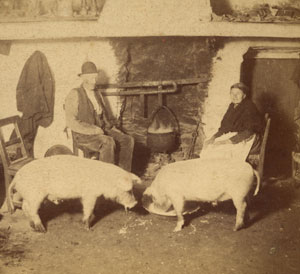Annotation:Pig in the Parlour
X:1 T:Pig in the Parlour M:C| L:1/8 B:John Walsh – The Second Book of the Compleat Country Dancing-Master (3rd edition) B: (London, 1735, No. 14, p. 8) N:Each strain twice Z:AK/Fiddler’s Companion K:F F2|AFEF AFEF|d2c4 BA|B2A2G2F2|EF G4 F2| AFEF AFEF|de f4 ed|e2 dc G2=B2|cGEG C2|| c2|ecBc ecBc|b2 a4 gf|e2d2c2B2|AG F4 c2| ecBc gcBc|ga b4 ag|afef gece|f2c2A2||
PIG IN THE PARLOUR. English, Reel or Country Dance Tune (cut time). F Major. Standard tuning (fiddle). AABB. The melody and country dance directions were first printed in London by music publisher John Walsh in his Second Book of the Compleat Country Dancing-Master, 3rd edition (1735), and in later editions of the same volume. It was also printed by John Johnson in his Choice Collection of 200 Favourite Country Dances, vol. 3 (1744) and by John Simpson in The Delightful Pocket Companion, vol. 2 (c. 1750). London musician Thomas Hammersely entered it into his 1790 music manuscript collection (as "Pig in Ye Parlour").

"Pig in a Parlour" has long been an English metaphor for something out of place, and perhaps unwelcome. So too, if one puts a 'pig in a parlour', it is still a pig (i.e. context does not alter character).

